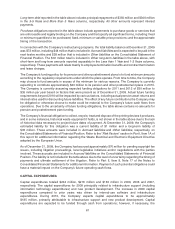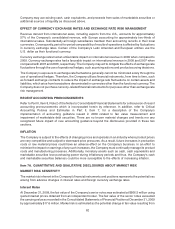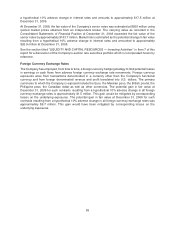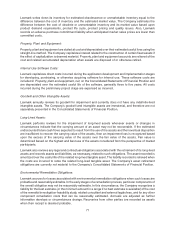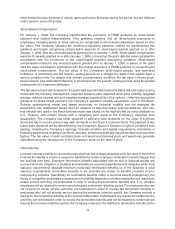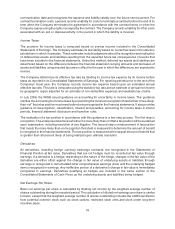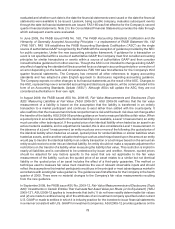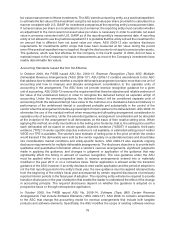Lexmark 2009 Annual Report Download - page 77
Download and view the complete annual report
Please find page 77 of the 2009 Lexmark annual report below. You can navigate through the pages in the report by either clicking on the pages listed below, or by using the keyword search tool below to find specific information within the annual report.Lexmark writes down its inventory for estimated obsolescence or unmarketable inventory equal to the
difference between the cost of inventory and the estimated market value. The Company estimates the
difference between the cost of obsolete or unmarketable inventory and its market value based upon
product demand requirements, product life cycle, product pricing and quality issues. Also, Lexmark
records an adverse purchase commitment liability when anticipated market sales prices are lower than
committed costs.
Property, Plant and Equipment:
Property, plant and equipment are stated at cost and depreciated over their estimated useful lives using the
straight-line method. The Company capitalizes interest related to the construction of certain fixed assets if
the effect of capitalization is deemed material. Property, plant and equipment accounts are relieved of the
cost and related accumulated depreciation when assets are disposed of or otherwise retired.
Internal Use Software Costs:
Lexmark capitalizes direct costs incurred during the application development and implementation stages
for developing, purchasing, or otherwise acquiring software for internal use. These software costs are
included in Property, plant and equipment, net, on the Consolidated Statements of Financial Position and
are depreciated over the estimated useful life of the software, generally three to five years. All costs
incurred during the preliminary project stage are expensed as incurred.
Goodwill and Other Intangible Assets:
Lexmark annually reviews its goodwill for impairment and currently does not have any indefinite-lived
intangible assets. The Company’s goodwill and intangible assets are immaterial, and therefore are not
separately presented in the Consolidated Statements of Financial Position.
Long-Lived Assets:
Lexmark performs reviews for the impairment of long-lived assets whenever events or changes in
circumstances indicate that the carrying amount of an asset may not be recoverable. If the estimated
undiscounted future cash flows expected to result from the use of the assets and their eventual disposition
are insufficient to recover the carrying value of the assets, then an impairment loss is recognized based
upon the excess of the carrying value of the assets over the fair value of the assets. Fair value is
determined based on the highest and best use of the assets considered from the perspective of market
participants.
Lexmark also reviews any legal and contractual obligations associated with the retirement of its long-lived
assets and records assets and liabilities, as necessary, related to such obligations. The asset recorded is
amortized over the useful life of the related long-lived tangible asset. The liability recorded is relieved when
the costs are incurred to retire the related long-lived tangible asset. The Company’s asset retirement
obligations are currently not material to the Company’s Consolidated Statements of Financial Position.
Environmental Remediation Obligations:
Lexmark accrues for losses associated with environmental remediation obligations when such losses are
probable and reasonably estimable. In the early stages of a remediation process, particular components of
the overall obligation may not be reasonably estimable. In this circumstance, the Company recognizes a
liability for the best estimate (or the minimum amount in a range if no best estimate is available) of the cost
of the remedial investigation-feasibility study, related consultant and external legals fees, and for any other
component remediation costs that can be reasonably estimated. Accruals are adjusted as further
information develops or circumstances change. Recoveries from other parties are recorded as assets
when their receipt is deemed probable.
71


